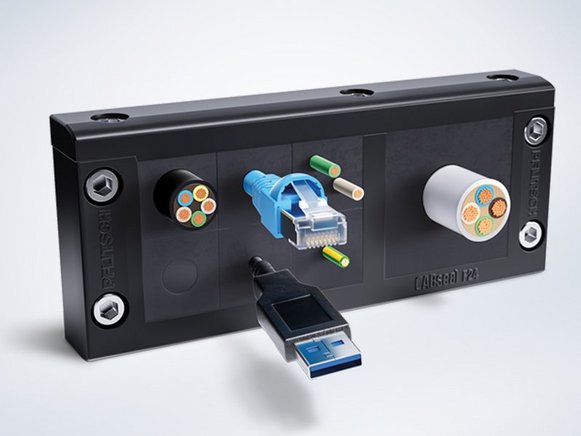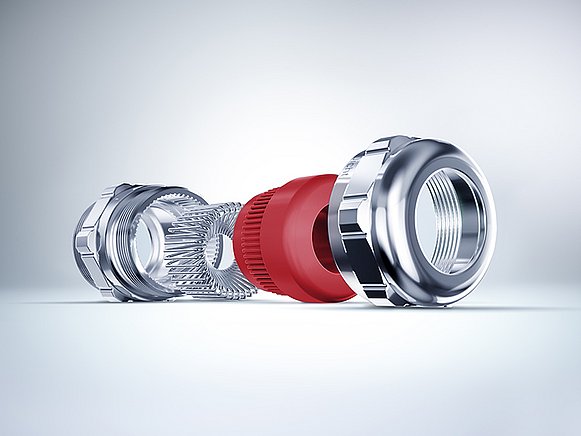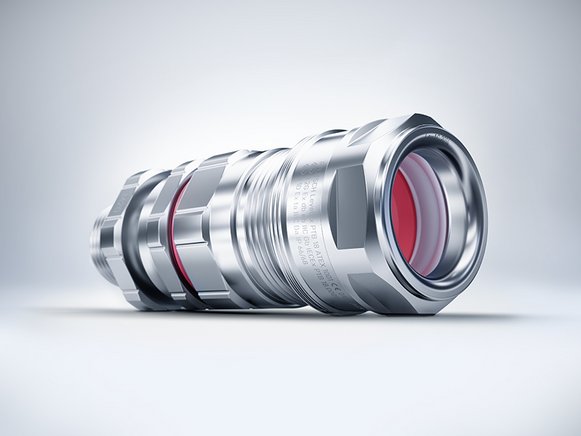Market insists on maximum reliability and ease of assembly
Cables remain the lifelines of automated processes, both now and in the future. From large cross-section power cables to the thinnest sensor cables, they must be routed not only safely through plants and machines but also easily and reliably. It’s a challenge that should not be underestimated. Jörg Sokat describes the solutions PFLITSCH provides to these challenges in an exclusive interview on product highlights at the HANNOVER MESSE 2023.
Mr Sokat, since the invention of modern cable glands a good 50 years ago, the cable entries have been regularly adapted to take account of new technological requirements. Have we meanwhile reached the point where their development potential is exhausted?
Sokat: First of all, I should emphasise that ever higher volumes of cabling are necessary in automated processes. There are umpteen sensors, actuators, motors and other components that have to be connected together at different field levels. In other words, we’re talking here about a wide variety of cables covering everything from sensitive fibre optics with a cross-section of no more than a few millimetres to power cables that will hardly bend at all. All of them need an entry that ensures reliable sealing regardless of the operating conditions – whether indoors or outdoors. Given this huge diversity, the ability to offer the right solution is a challenge that is virtually impossible to meet with simple, standard products. EMC and explosion protection, pre-assembled cables and high operating temperatures are just some of the pitfalls awaiting our developers.
How are you responding to the growing use of ready-to-install modules?
Sokat: The trend towards pre-assembled cables is not as new as you might think. A while ago now, we developed cable glands with split sealing inserts a while ago, which we later followed up with fully splittable flange systems and cable glands, into which the cables are inserted prior to assembly. That way, users are not obliged to dis- and reassemble the connector and there is no impact on the module’s operational reliability. Our fully splittable UNI Split Gland is well-established wherever only a small number of cables need to be inserted, for example with camera systems or functional lights.
And what about the rising volume of cables in control cabinet construction?
Sokat: For larger numbers of cables, we’ll be showing our new CABseal at the Hannover Messe, which is available in four frame sizes based on the standard cut-outs in control cabinets. The frames can be equipped with various grommets for easy installation of up to 40 cables. All grommets achieve the high IP 66 type of protection and form a reliable seal to both the cable and the enclosure. The advantage here is that the fitter is free to position the cables as necessary and there are no restrictions if the frames have different designs. We make the CABseal frames from glass fibre reinforced polyamide with an integrated, moulded elastomer seal, so that no additional flat gasket is required at the enclosure cut-out. What’s more, all frames have a low-profile design with a mounting height of only 20 mm, which is perfect whenever installation space is limited. On top of that, the flush grommets result in a completely closed surface with neither creases nor edges.
Ever higher data rates and installation densities mean that electromagnetic compatibility is increasingly an issue for developers and users in the automation industry. What’s the situation in this segment?
Sokat: EMC is an excellent example of false economies ending up costing more – when expensive system retrofits become unavoidable owing to errors, failures and waste. That’s why we advise people to choose safe and reliable solutions from the outset. Alongside classic contacting of the cable shield with so-called cones, the trend today is towards spring bonding, which is easier to assemble. Unfortunately, many EMC cable glands with spring bonding have significant drawbacks when it comes to screening attenuation and current-carrying capacity. We’re unwilling to make that kind of compromise, which is why we launched the integrated triangular spring as a solution that not only guarantees quick and easy assembly but at the same time achieves excellent screening attenuation values and allows high leakage currents. Our customers are full of praise for the durable contact between the TRI spring and the cable shield, even when subject to vibration.
What new EMC products will you be introducing at this year’s fair?
Sokat: We’re expanding our EMC portfolio this year with the UNI Dicht TRI, which combines the TRI spring’s EMC benefits with the inherent advantages of the UNI Dicht system. Specifically, this adds up to an ultra-compact cable gland with a large number of variants and the proven anti-twist protection, making it a perfect complement to the blueglobe TRI. Another point in its favour is that the design enables even the smallest shield diameters to be contacted. For instance, any cable with a shield from 3 to 16 millimetres in diameter can be installed using the UNI Dicht TRI in size M25. Apart from sealing over a large area, the UNI Dicht concept also prevents constriction of the cable sheathing for more durable and safe installations.
Explosion protection is a complex field. Innovations are only rarely implemented because the certification procedure is very time-consuming. PFLITSCH wants to set benchmarks here too nevertheless. How exactly?
Sokat: The Ex cable glands that are already firmly established in the market often seem very bulky and they’re not exactly easy to install. Our new LevelEx series provides the answer here. The name says it all – the next level in terms of safety and ease of assembly is now available. The series convinces with a compact design, only a few parts and a wide range of potential applications for Group II equipment with the “Ex d” and “Ex e” ignition protection types for gas and dust. LevelEx glands consist of a relatively small number of components: the sealing elements have a captive design and cannot be lost during assembly. Rubber rings and an assortment of washers – which are not at all unusual with conventional Ex d cable glands – are now a thing of the past. When the pressure screw is tightened, the seal is deformed over a large area and achieves excellent tightness with IP 66 or IP 68 protection. The strain relief values are likewise above average thanks to the PFLITSCH concept. With its large temperature window, the LevelEx is universally suited in extreme environments and temperatures, which are the norm in offshore applications, deserts or the polar regions. And in the double-sealing AC version, it is also the ideal solution for armoured cables. Last but not least, I don’t need to tell you that LevelEx cable glands ship with all essential international approvals.
All the above product highlights from PFLITSCH will be on show live at the HANNOVER MESSE: Hall 12, Stand E04. Request your free trade fair tickets here: messe(at)pflitsch.de.




